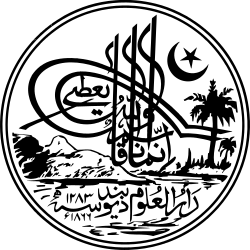Imdadullah Muhajir Makki
Imdadullah Muhajir Makki (1814 – 1896)[1][2] was an Indian Muslim Sufi scholar following the Chishti Sufism.[3][4]
Sayyidut Taa’ifah Haji Imdadullah Muhajir Makki | |
|---|---|
| Personal | |
| Born | 1 January 1814 Nanauta, Northern Provinces, British India |
| Died | 3 February 1896 (aged 82) |
| Religion | Islam |
| Muslim leader | |
Disciples
| |
| Part of a series on |
| Deobandism |
|---|
 |
| Ideology and influences |
| Founders and key figures |
|
| Notable institutions |
| Centres (markaz) of Tablighi Jamaat |
| Associated organizations |
Early life
Imdadullah Muhaajir Makki was born in Nanauta, a town in the district of Saharanpur in Uttar Pradesh, India in 1814.[1]
| Part of a series on Islam Sufism |
|---|
|
List of sufis |
|
|
Religious work and travels
At the age of eighteen, his bay'at was accepted by Nasiruddin Naqshbandi.[1] Later he went to study under Mianji (Noor Mohammad Jhanjhanvi), as an initiate of the Chishti-Sabiri Sufi order, but after Mianji's death he temporarily became a semi-recluse. After wandering in the wilderness for six months he was overcome by a strong urge to travel to Medina. On December 7, 1845, he arrived at Banares. From there, he departed for Arabia for Hajj and pilgrimage of the tomb of shrine of Muhammad.[1]
After the completion of his hajj, Imadadullah remained with Ishaq Muhajir Makki and others. Shah informed him that, after his pilgrimage to Medina, he should return to India. Sayyid Qudratullah Banarasi Makki sent several of his murids to accompany him to Medina.
Freedom struggle against the British
In Thana Bhawan, the local Sunnis declared Imdadullah their leader. In May 1857 the Battle of Shamli took place between the forces of Haji Imdadullah and the British.[5]
Marriages
Imdadullah married for the first time when he was 48 years old. After the death of his first wife, he married a blind widow. Because she was blind, she could not manage all household work, so she requested him to take another wife so all household work. Imdadullah then married for the third time. None of his three wives bore him children.[5]
Poetry
Examples
In Makki's poem in Imdad ul Mushtaq regarding his teacher Noor Muhammad, he says:
تم ہو اے نور محمد خاص محبوب خدا
ہند میں ہو نائب حضرت محمد مصطفیٰ
تم مدد گار مدد،امداد کو پھر خوف کیا
عشق کی پر سن کے باتیں کانپتے ہیں دست و پا
اے شہ نور محمد،وقت ہے امداد کا
آسرا دنیا میں ہے از بس تمہاری ذات کا
This translates into English as:
You are, O Noor Muhammad, the remarkably beloved of Allah; you are the deputy of Hazrat Muhammad Mustafa pbuh in India.
You are the helper then what to worry for assistance, but hands and feet shiver when hear communications of love (‘Ishq).
O master Noor Muhammad! This is the time for assistance; the only reliance in the world is your personality.”[6]
Literary works
His books include:
- Kulliyat-e-Imdadiya[7]
- Hashiya Mathnavi Moulana Rumi: This is an annotation in Persian on the Mathnawi-i Ma’nawi by Rumi. During Imadadullah's lifetime, only two parts could be printed. The remainder was printed after his death.
- Ghiza-e-Ruh (The Nourishment of the Soul): Imadadullah wrote this book in 1264 AH. Mianji Noor Mohammad Jhanjhanvi is also discussed. It consists of 1600 verses of poetry.
- Ikleelul Quran (Tafseer Quran in Arabi). First Published in Bahraich by Taj Offcet Press formerly Aqeel Press NazirPura Bahraich
- Jihad-e-Akbar (The Greater Jihad): He composed this book in 1268 AH. It is a poetic work in Persian that he translated it into Urdu. It consists of 17 pages with 679 verses.
- Mathnavi Tuhfatul Ushshaq (Mathnavi – A Gift for Lovers): This consists of 1324 poetic verses and was compiled in 1281 AH.
- Risala Dard Ghamnak (The Treatise of Painful Sorrow): It consists of 5 pages with 175 verses.
- Irshad-e-Murshid (The Directive of the Murshid): This book deals with wadha'if, muraaqabaat, aurad, and shajaraat of the four silsilas. It was written in 1293 AH.
- Zia ul Quloob (Glitter of the Hearts): This book is in Persian. He wrote this kitab in Makkah in 1282 AH on the request of Hafiz Muhammad Yusuf, the son of Hafiz Muhammad Zamin.
Death
Imadadullah was of frail physical stature. In his last years, his body deteriorated to such an extent that, towards his death, it became difficult for him to even turn onto his side. He died in 1896 at the age of eighty-two.[1][5]
See also
- Muhammad Mian Mansoor Ansari
- Najib Ali Choudhury, his student
References
- http://www.hadhrat.com/haji-imdadullah-muhajir-makki-r-a/, Profile of Haji Imdadullah, Retrieved 26 March 2017
- Scott A. Kugle, Sufis and Saints' Bodies, p 222. ISBN 0807872776
- Scott A. Kugle, Sufis and Saints' Bodies, p 223. ISBN 0807872776
- Sherali Tareen (Franklin & Marshall College Lancaster, Pennsylvania), Haji Imdadullah’s Hermeneutics of Reconciliation, p 3.
- https://archive.org/details/HajiImdadullah2 Profile of Haji Imdadullah, Retrieved 26 March 2017
- Imdad ul Mushtaq. Ashraf Ali Thanvi and Mushtaq Ahmed. p. 116.
- https://islamicbookslibrary.wordpress.com/?s=Haji+Imdadullah+&submit=Search, Books written by Haji Imdadullah on Islamic Books Library website, Published 15 December 2011, Retrieved 26 March 2017